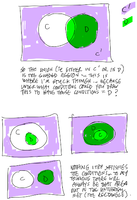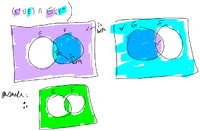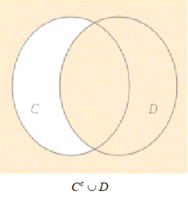Venn diagram shading
- Thread starter ry7
- Start date
Dr.Peterson
Elite Member
- Joined
- Nov 12, 2017
- Messages
- 16,822
You appear to be taking D to be the universe (the rectangle that contains everything). It could be, but that is not the most general case, so we don't draw the diagrams with such an assumption.
It is true that [MATH]C^c\cap D = D[/MATH] if [MATH]D = U[/MATH]; but it is also true whenever [MATH]C\subset D[/MATH].
It is not true that [MATH](C^c\cup D^c)^c = \varnothing[/MATH] when [MATH]D = U[/MATH]. Rather, [MATH](C^c\cup U^c)^c = C[/MATH]. If you want to know when this statement is true, you don't have a solution yet.
Now, was your question about whether D = U is the solution to the compound statement [MATH]C^c\cap D = D[/MATH] AND [MATH](C^c\cup D^c)^c = \varnothing[/MATH]? Or are you just asking whether your Venn diagrams represent these two statements? Or what?
Please state the actual exercise you are working on, word for word and completely, so we can be sure what you need to do.
It is true that [MATH]C^c\cap D = D[/MATH] if [MATH]D = U[/MATH]; but it is also true whenever [MATH]C\subset D[/MATH].
It is not true that [MATH](C^c\cup D^c)^c = \varnothing[/MATH] when [MATH]D = U[/MATH]. Rather, [MATH](C^c\cup U^c)^c = C[/MATH]. If you want to know when this statement is true, you don't have a solution yet.
Now, was your question about whether D = U is the solution to the compound statement [MATH]C^c\cap D = D[/MATH] AND [MATH](C^c\cup D^c)^c = \varnothing[/MATH]? Or are you just asking whether your Venn diagrams represent these two statements? Or what?
Please state the actual exercise you are working on, word for word and completely, so we can be sure what you need to do.
Dr.Peterson
Elite Member
- Joined
- Nov 12, 2017
- Messages
- 16,822
So draw a Venn diagram for each of the two conditions (with both B and C being ordinary circles), and determine what relationship each requires. I told you incorrectly what the first implies, so start fresh for yourself, rather than trust what I've said. Once you've determined how the sets must be related (for example, if you found that [MATH]C\subset D[/MATH]), draw the sets with that relationship (in my [wrong] example, draw C inside D) and make the appropriate shading for each of the two statements. (My understanding is that they don't want shading in the final product, but by doing two separate diagrams with shading, you can show that the conditions are met.Hi Dr. Peterson,
The exact question is ‘Draw a single Venn diagram that satisfies the the stated condition(s):’
C’ union D = D and (C’ union D’)’ = the empty set
I’m sure I’m wrong about D = the universal set.
To be honest, I've tried doing this too much in my head, and struggled. In order to be sure I'm not making mistakes, I ended up proving some basic facts, such what it means if [MATH]A\cup B = B[/MATH] or [MATH]A\cup B = U[/MATH] or [MATH]A\cap B = \varnothing[/MATH]. Then I used those to rewrite the given conditions in more basic forms. The answer is sort of like your wrong answer that D = U, in that the sets are not the way you normally draw them.
(As an aside, I learned just a few years ago that, technically, only the generic diagram with circles overlapping in all possible ways is called a Venn diagram; what they are really asking you to draw (as I read it) is an Euler diagram, in which the actual relationship of the sets is visible. People often use the former term to mean the latter.)
Last edited:
Dr.Peterson
Elite Member
- Joined
- Nov 12, 2017
- Messages
- 16,822
Those are fun pictures! They make me think of a children's book illustration! And, yes, you clearly understand the ideas.
But the problem is, indeed, a challenge to your imagination. That's why I made a mistake originally.
Looking at the first condition, you want the union to coincide with D, so which region must not exist? The region outside both circles! That is, [MATH](C\cup D)^c[/MATH] has to be empty. To make that happen, you need [MATH]C\cup D = U[/MATH] -- it has to fill up the universe! So your final answer won't have circles at all (like your three nicely done attempts); it will be a rectangle divided into three (or less) regions. That's not one of the possibilities you think of when you go to draw an Euler diagram.
Now think similarly about the second condition. What region in that Venn diagram has to be empty? (If you know De Morgan's Laws, you can simplify the condition to answer that question more quickly, but clearly you know how to draw the diagram without help.)
Then make a new diagram that still satisfies the first condition, but now also makes another region empty. The answer turns out to be very clean.
But the problem is, indeed, a challenge to your imagination. That's why I made a mistake originally.
Looking at the first condition, you want the union to coincide with D, so which region must not exist? The region outside both circles! That is, [MATH](C\cup D)^c[/MATH] has to be empty. To make that happen, you need [MATH]C\cup D = U[/MATH] -- it has to fill up the universe! So your final answer won't have circles at all (like your three nicely done attempts); it will be a rectangle divided into three (or less) regions. That's not one of the possibilities you think of when you go to draw an Euler diagram.
Now think similarly about the second condition. What region in that Venn diagram has to be empty? (If you know De Morgan's Laws, you can simplify the condition to answer that question more quickly, but clearly you know how to draw the diagram without help.)
Then make a new diagram that still satisfies the first condition, but now also makes another region empty. The answer turns out to be very clean.
pka
Elite Member
- Joined
- Jan 29, 2005
- Messages
- 11,989
Dr.Peterson
Elite Member
- Joined
- Nov 12, 2017
- Messages
- 16,822
This is just what ry7 showed (first picture, ignore the distinction of colors); he/she understands this part well. The problem goes well beyond making the diagram.
Dr.Peterson
Elite Member
- Joined
- Nov 12, 2017
- Messages
- 16,822
Excellent!
The first condition is equivalent to [MATH]C^c\subseteq D[/MATH], so that [MATH]C\cup D = U[/MATH]; and the second is equivalent to [MATH]C\cap D = \varnothing[/MATH]. Together, they imply that [MATH]C^c = D[/MATH].
The first condition is equivalent to [MATH]C^c\subseteq D[/MATH], so that [MATH]C\cup D = U[/MATH]; and the second is equivalent to [MATH]C\cap D = \varnothing[/MATH]. Together, they imply that [MATH]C^c = D[/MATH].
pka
Elite Member
- Joined
- Jan 29, 2005
- Messages
- 11,989
Surely we can all agree that the diagrams leave something to be desiredThis is just what ry7 showed (first picture, ignore the distinction of colors); he/she understands this part well. The problem goes well beyond making the diagram.
Dr.Peterson
Elite Member
- Joined
- Nov 12, 2017
- Messages
- 16,822
As I mentioned in passing, technically, a Venn diagram does not allow this, but must be generic; but what we came up with here (and what I am pretty sure must be what was expected) is commonly called a Venn diagram. Be sure to let us know if you are told that something different is called "correct".That is awesome! I had no idea that was ‘allowed’ in Venn diagrams, but it’s so elegant- as you say, very clean.
Thanks for your help?
Steven G
Elite Member
- Joined
- Dec 30, 2014
- Messages
- 14,591
Am I still asleep or is your statement not true. Suppose x is in C, then x is not in Cc. Then x is not in [MATH]C^c\cap D[/MATH] and [MATH]C^c\cap D [/MATH]=DIt is true that [MATH]C^c\cap D = D[/MATH] if [MATH]D = U[/MATH]; but it is also true whenever [MATH]C\subset D[/MATH].
Dr.Peterson
Elite Member
- Joined
- Nov 12, 2017
- Messages
- 16,822
You're partly asleep. You just missed my subsequent comments:
... I told you incorrectly what the first implies, so start fresh for yourself, rather than trust what I've said. ... if you found that [MATH]C\subset D[/MATH]), draw the sets with that relationship (in my [wrong] example, draw C inside D ...
To be honest, I've tried doing this too much in my head, and struggled.
Yes, I was wrong there, but I couldn't go back and edit it. All I could do was to proclaim my error repeatedly.But the problem is, indeed, a challenge to your imagination. That's why I made a mistake originally.
Dr.Peterson
Elite Member
- Joined
- Nov 12, 2017
- Messages
- 16,822
This is the specific correction of the previous error; I had just left off a complement, having juggled too many of them in my head without writing any of it down.The first condition is equivalent to [MATH]C^c\subseteq D[/MATH], so that [MATH]C\cup D = U[/MATH]





